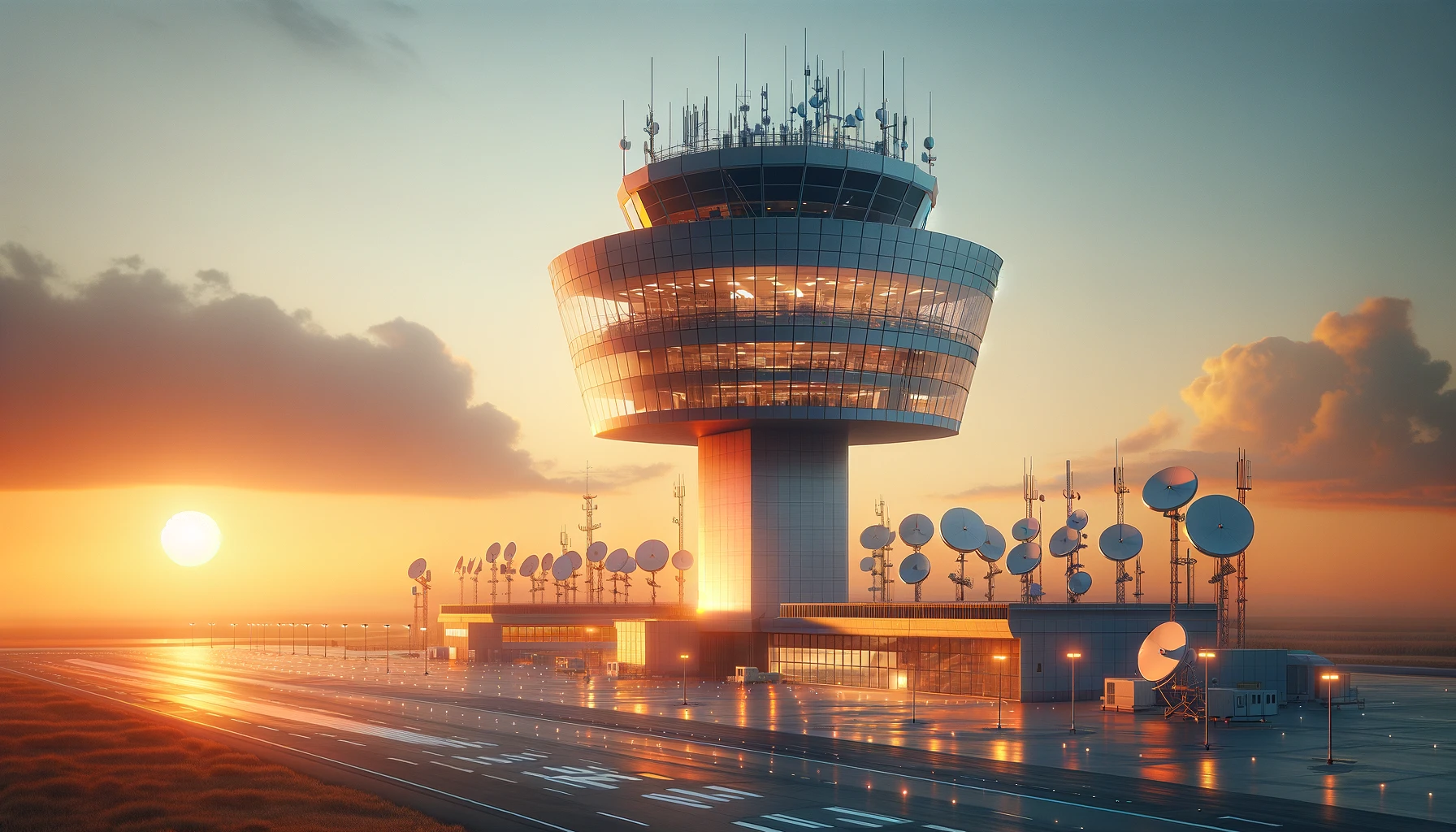Behind the Scenes: How Air Traffic Control Works
Air travel is a large part of modern transportation. Every day thousands of aircraft crisscross the skies and carry millions of passengers and tons of cargo. Behind the seamless operation of this vast network lies a critical and often overlooked component: air traffic control (ATC).
Air Traffic Control
Air traffic control is the cornerstone of modern aviation safety. It is tasked with the complex job of managing the flow of aircraft through various phases of flight and across different sectors of airspace. ATC's primary mission is to prevent collisions, organize and expedite the flow of air traffic and provide information and other support for pilots.

The Role of Air Traffic Controllers
There are over 14,000 air traffic controllers in the United States alone, each highly trained to handle the unique demands of their roles. Controllers work in a variety of settings including:
Tower Control: These controllers manage all aircraft operations at the airport itself, including takeoffs, landings, and ground traffic.
Approach and Departure Control: These controllers manage aircraft as they transition between the airport and high-altitude en-route sectors, ensuring a smooth handoff to and from the tower controllers.
En Route Control: Operating in facilities known as Air Route Traffic Control Centers (ARTCCs), these controllers manage aircraft during the cruise phase of their flight across vast distances.
The Structure of Air Traffic Control
The airspace over any country is highly regulated and divided into various sectors that help manage the flow of air traffic efficiently. In the United States, airspace is categorized into classes A through E, each with distinct rules and operational guidelines:
Class A Airspace: Generally from 18,000 feet mean sea level (MSL) up to and including flight level 600. This airspace is exclusively for IFR (Instrument Flight Rules) operations.
Class B Airspace: The structure is designed to contain all published instrument flight routes and to provide a buffer above and below the airspace.
Class C Airspace: Generally, airspace from the surface to 4,000 feet above the airport elevation surrounding those airports that have an operational control tower, are serviced by radar approach control, and that have a certain number of IFR operations or passenger enplanements.
Class D Airspace: Generally, airspace from the surface to 2,500 feet above the airport elevation surrounding those airports that have an operational control tower.
Class E Airspace: Covers all other airspace that is not classified as Class A, B, C, or D, and is controlled airspace where IFR and VFR (Visual Flight Rules) flight is permitted.
The delineation of airspace is critical to managing the diverse needs of different types of air traffic, such as commercial, private, or military flights, each of which may have different priorities and requirements.
The Technology Behind Air Traffic Control
Air traffic control is not only a testament to human capability and coordination but also a field driven by advanced technology. The systems and tools employed by ATC are sophisticated and are designed to ensure precision and safety in managing the skies. Let's explore some of the key technologies that form the backbone of air traffic control operations.
1. Radar Systems: The Eyes of ATC
Radar (Radio Detection and Ranging) technology is fundamental to air traffic control. It allows controllers to "see" aircraft positions in the airspace by sending out radio waves that bounce back when they hit an object, such as an aircraft. There are two main types of radar used in ATC:
Primary Radar: This detects and locates aircraft by the reflection of radio signals and provides basic information such as range and bearing from the radar site.
Secondary Radar: More sophisticated than primary radar, secondary radar requires aircraft to have transponders that respond to signals sent from the radar station. This response provides more detailed information, including the aircraft's identity, speed, and altitude.
2. Automatic Dependent Surveillance-Broadcast (ADS-B)
ADS-B is set to replace radar as the primary surveillance method for controlling aircraft worldwide. It uses satellite navigation to allow aircraft to broadcast their location to ground stations and other aircraft in real time. This technology enhances the accuracy of aircraft location data and significantly improves situational awareness for both pilots and air traffic controllers.
3. Flight Data Processing Systems
These systems collect, process, and display a wide array of data that is crucial for effective air traffic management. This includes flight plans, meteorological data, radar information, and surveillance data. The integration of this data ensures that air traffic controllers have a comprehensive understanding of the airspace and all active flights, enabling them to make informed decisions quickly.
4. Voice Communication Systems
Reliable communication is the cornerstone of air traffic control. Voice communication systems enable controllers to speak directly with pilots, issuing instructions and receiving acknowledgments. These systems are supported by high-frequency (HF) radios for long-distance communication, very high-frequency (VHF) radios for short-range communication, and satellite communications where terrestrial networks are unavailable.
The Challenges of Air Traffic Control
Despite the advancements in technology, air traffic control faces several significant challenges that impact its efficiency and reliability:
1. Increasing Air Traffic
The number of flights has steadily increased over the years, putting immense pressure on ATC systems and controllers. Managing more aircraft in the same airspace necessitates higher levels of precision and operational efficiency.
2. Weather Disruptions
Weather is unpredictable and can have a profound impact on flight schedules and air traffic management. Controllers must be adept at quickly rerouting flights to avoid bad weather, which can be a complex logistical challenge.
3. Equipment Failures
While ATC technology is generally reliable, equipment failures can and do happen. Such failures can lead to delays and, in the worst cases, safety risks. Regular maintenance and upgrades are critical to minimizing these risks, but they cannot eliminate them entirely.
4. Staffing Shortages
The high stress and demanding nature of air traffic control work require a steady influx of new controllers to replace those retiring or leaving the profession. However, training new controllers is time-consuming and expensive, leading to periodic staffing shortages that can strain the system.

Navigating the Future of Air Traffic Control
As we look toward the future, air traffic control (ATC) stands on the cusp of significant transformations, driven by technological innovation and increasing demands on global air travel systems. These advancements promise to enhance the capabilities of ATC, providing more efficient, safer, and more responsive operations.
Innovations Enhancing ATC Operations
Integration of Artificial Intelligence (AI) and Machine Learning (ML): AI and ML are set to revolutionize air traffic management by automating routine tasks, optimizing flight routes in real-time, and enhancing predictive maintenance of ATC equipment. These technologies can analyze vast amounts of data to identify patterns and predict potential issues before they arise, allowing for proactive management of airspace and equipment.
Space-Based ADS-B: Expanding ADS-B capabilities to a global scale involves deploying satellites equipped with ADS-B receivers. This development will enable real-time tracking of aircraft anywhere on the planet, including oceanic and remote areas where ground-based surveillance is currently limited. Space-based ADS-B not only enhances global air traffic surveillance but also improves the efficiency and safety of route planning over vast and previously unmonitored regions.
Digital Towers: Remote and digital towers are an emerging concept where air traffic services are managed by controllers who are not physically present at the airport. These systems use high-definition cameras and sensors to provide a virtual view of the airport environment. Digital towers can reduce operational costs, extend ATC capabilities to more airports, and provide enhanced visual aids to controllers, such as augmented reality overlays that show critical flight information.
Increased Automation in ATC: Automation in air traffic control is advancing, with systems increasingly capable of handling complex decision-making processes required for safe airspace management. These systems can assist controllers by suggesting optimal traffic flows, detecting potential conflict between aircraft, and automating routine communications with pilots.
Overcoming Challenges and Embracing Opportunities
While the path forward is lined with cutting-edge technology, the integration of these systems poses substantial challenges. The transition to more automated systems requires rigorous testing to ensure they meet the high safety standards required in aviation. Additionally, there is a need for significant training and adaptation among ATC personnel to effectively integrate these new tools into daily operations.
Moreover, as these technologies become more prevalent, cybersecurity becomes an increasingly critical concern. Protecting the data and systems that control global air traffic from cyber threats is paramount. Continuous investment in cybersecurity measures and protocols is essential to safeguard the integrity of air traffic control operations.
The Sky's the Limit
As we consider the future of air traffic control, it's clear that the industry is poised for a significant transformation that promises to enhance the efficiency and safety of air travel. From artificial intelligence to space-based ADS-B, the next generation of ATC technology will enable smoother, faster, and more reliable air travel. However, embracing these innovations requires careful consideration of their implementation and impacts on current systems.
The evolution of ATC is not just about adopting new technologies; it's about enhancing the capability to manage the skies more effectively. Every innovation brings us closer to a future where air travel achieves unprecedented levels of safety and efficiency. As these advancements unfold, they will undoubtedly redefine the boundaries of what's possible in aviation, ensuring that ATC continues to be a vital backbone of global transportation.
For anyone involved in or interested in aviation, these developments are not just exciting; they are essential to the sustainable growth of air travel. As SkyShop continues to provide detailed insights into airplane delivery services and more, we stay committed to keeping you informed on the latest in air traffic control and beyond, ensuring that whether you're a seasoned aviator or an enthusiastic observer, you're always ahead of the curve.
